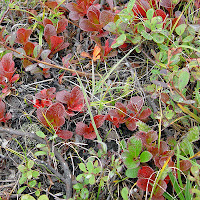Alaska Trees and
Shrubs, by Leslie A. Viereck and Elbert L. Little, Jr., is a great
reference for learning about the woody plants in Alaska (and extending into the Pacific Northwest and Russia). I pulled out my copy
as a refresher before our trip to Anchorage earlier this month. The book is
published by the U.S. Department of Agriculture. My hardback version was published
in 1972, but you can pick up a soft cover of the later version on Amazon.
The audience includes scientists, naturalists, and anyone interested in nature. The book includes a list of Alaskan tree and shrub species
(mostly native, some naturalized), and notes that identification is easy
because there are so few species (the 1972 version lists 19 plant families, 54
genera, and 128 species). It describes the main vegetation categories,
including coastal forests, interior forests, and tundra; and provides a color
coded vegetation map that identifies the vegetation types (coastal
spruce-hemlock forests, closed spruce-hardwood forests, open growing spruce
forests, treeless bogs, shrub thickets, moist tundra, wet tundra, alpine
tundra, and ice and snow). The book provides identification keys, including
winter identification keys for deciduous trees.
The descriptions of each species go beyond physical
descriptions to include usage, history, and useful information. For example,
the entry for Western Crabapple (Malus
diversifolia) states that the fruit was eaten by Native Americans and is
used in jellies and preserves. The entry for Sitka Spruce (Picea sitchensis) provides information about old growth trees and
experimental trees planted on the Aleutian Islands. The illustrations, rendered
by several artists, are beautiful and detailed. We studied many of the tree families in my Tree ID class at Merritt College—such as Betulaceae, Cupressaceae, Pinaceae, Salix,
and Taxaceae.
This book is also special on a personal level. My dad, Arland S. Harris, is acknowledged for contributing information on trees and shrubs in
Southeast Alaska (the Sitka Spruce tree is one of his specialties). Also, the
bibliography includes names that I recognize from my childhood – scientists with
whom my dad collaborated, or who came to dinner. Names like Wilbur (Bill) Farr,
Paul Haack, Karl Hegg, Keith Hutchison, T. H. Laurent, and Ray Taylor (whom I
mentioned in the Mill Creek post).
































